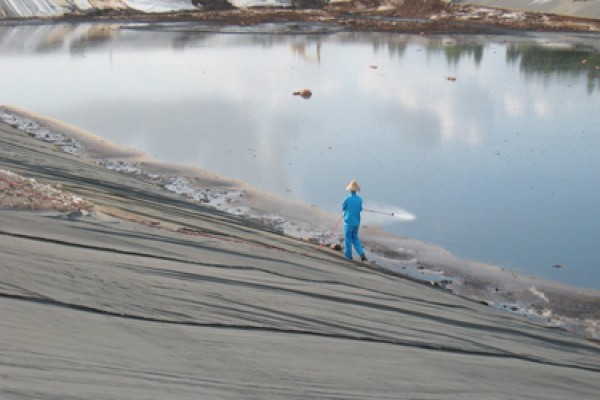Improper management of septic tanks can be solved with deodorants
Septic tanks are improperly managed and designed in daily life, causing organic waste to decay and emit unpleasant odors or even foul odors. They can also produce leachate, causing significant pollution to human health and the environment, affecting people's daily lives. Septic tanks are a treatment facility that uses sedimentation and anaerobic fermentation principles to remove suspended organic matter from domestic wastewater, and are classified as primary transitional life treatment structures. Septic tank deodorants can suppress the evaporation of odor, have a good effect, fundamentally solve the problem, and are pollution-free.
However, septic tank deodorizers have a certain effect on inhibiting microbial growth and reproduction, but their persistence is poor. Microbial septic tank deodorizers use chemicals to react with odor components, which have a good effect on suppressing odor evaporation but have significant side effects and are prone to secondary pollution.
Domestic sewage contains a large amount of feces, paper scraps, and pathogens The concentration of suspended solids is 100-350mg/L, and the concentration of organic matter CODCr is between 100-400mg/L. Among them, the concentration of suspended organic matter BOD5 is 50-200mg/L. After 12 to 24 hours of sedimentation, sewage entering the septic tank can remove 50% to 60% of suspended solids. The deposited sludge undergoes anaerobic fermentation and decomposition for more than 3 months, causing the organic matter in the sludge to decompose into stable inorganic substances. The perishable raw sludge is transformed into stable mature sludge, changing the structure of the sludge and reducing its moisture content. Regularly remove and transport sludge for landfill or use as fertilizer. Requirement: The calculation volume of the sedimentation and falling parts of the septic tank should be confirmed in accordance with Article 4.8.4-4.8.7 of the Design Code for Construction of Water Supply and Drainage (GB50015-2003). The retention time of sewage in septic tanks should be selected from 12h to 24h. For sewage treatment systems without sludge disposal, the capacity of septic tanks should also include the capacity to store sludge.

Application of septic tanks
Septic tanks are equipment that uses microorganisms to biodegrade excrement, but the current operation of septic tanks is not ideal. Excessive solid sediment and clumping greatly reduce the useful volume of the tank, requiring frequent pumping. The retention time of excreta is too short, which greatly affects the degradation process. The ground is filled with water and the odor is unbearable.
During the treatment process of septic tanks, it is important to carefully select chemical cleaning agents. Do not use chlorine containing, anti-corrosion and bactericidal agents, strong acids and bases, or cationic surfactants; This product has strong efficacy, accelerates the fragmentation of solid substances, reduces the number of pumping cycles, and lowers costs.
For the treatment of septic tanks, product application is divided into two stages:
Launch and use stage (newly used septic tank): Taking a 100 cubic septic tank as an example, an additional 10 kilograms of this product will be added. According to the actual situation, after 6 months, an additional 10 kilograms of this product will be added; Normal use stage (septic tanks with longer usage time): Before using this product, check the storage tank. If there are any of the following conditions, it is necessary to use a pump for suction first. Pump for 2-3 weeks before adding this product; Function of septic tank deodorizer
This product is used for digesting and decomposing organic waste. It can degrade and convert organic waste such as protein, starch, fat, oil, toilet paper, and food residue into water, carbon dioxide, and trace minerals, effectively removing odors and stains.
The primary application areas of biological agents for deodorization and pollution reduction in septic tanks and bathrooms are septic tank deodorization and reduction;
Deodorization of toilets and pet nests;
Vehicles and ships are equipped with built-in waste bins, which can deodorize and reduce waste.
Septic tanks and biological agents for deodorization and pollution removal in toilets have been successfully applied in many fields around the world, including industry, civil use, animal husbandry, and agriculture, and have played a role in many fields, solving many technical problems.
Deodorizing effect
Septic tank deodorant deodorization: using bacteria to act in the odor source, suppress the occurrence of odor, has a good effect, and fundamentally solves the problem. This product includes beneficial bacteria that are naturally collected, and the activity of biological enzymes is also strong. It can effectively digest organic waste and is pollution-free. If used, it can be diluted by half a liter of water to 10 grams of this product. Pour in the mixture, and if necessary, repeat the treatment.
The article originates from a deodorant manufacturer http://www.scneng.com.hk
-
06-11
"Environmental Doctor" Du Siyuan: Environmental Protection is a Lifestyle Attitude
There is a Hong Kong compatriot in Jiangmen who often frequents various farms and plantations, walks in mechanical factories, and is seen by others as the nemesis of environmental problems. He conside
-
03-16
Deodorant manufacturer: Deodorants reduce soil pollution
Waste is a chaotic mixture of various components. The accumulation of debris on the surface of soil can cause some chemical reactions, releasing harmful gases, which can lead to soil pollution and eve
-
12-01
Deodorant Manufacturers: Differences between Microbial Deodorants and Traditional Deodorants
The waste that is not needed in our daily life and work is called waste. Due to the large amount of waste discharged and the complex categories, there are great difficulties in reducing waste and deod
-
11-08
Application of Deodorant Manufacturers in Domestic Waste Treatment
Garbage is the waste generated in everyone's daily life and work. Due to its large discharge volume and complex and diverse composition, it poses great difficulties in reducing and deodorizing wa
